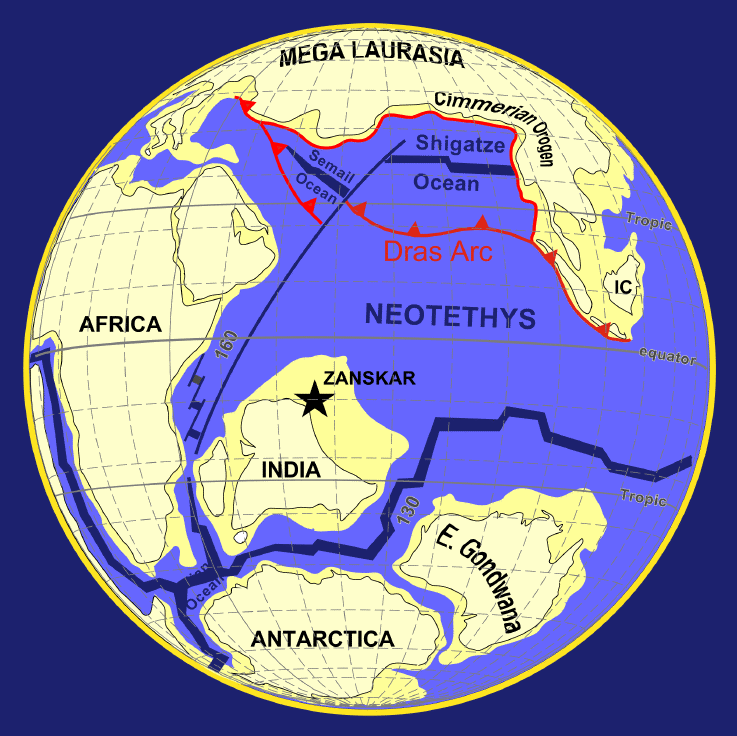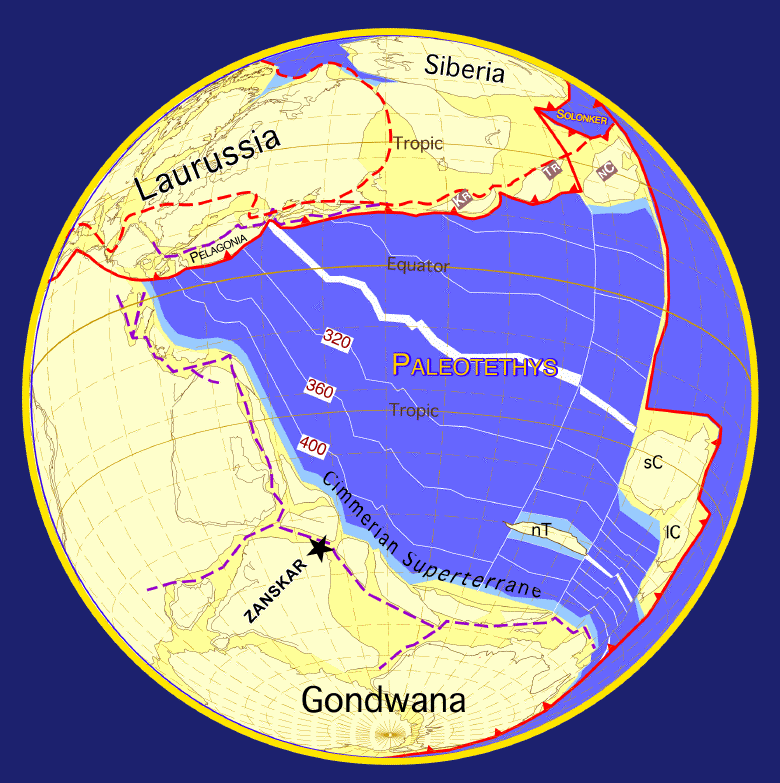|
Cambaytherium
''Cambaytherium'' is an extinct genus of placental mammals in the family Cambaytheriidae whose fossils were found in an open pit coal mine located in Gujarat, India. The mine was a treasure trove full of teeth and bones, over 200 of which were identified as belonging to ''Cambaytherium thewissi.'' The fossils were dated to the Early Eocene, 54.5 million years ago, making them slightly younger than the oldest known fossils belonging to the order Perissodactyla. Description ''Cambaytherium'' was a genus of herbivorous four-legged quadrupeds. The best-known species, ''C. thewissi'', has been estimated to have weighed around , while the smaller ''C. gracilis'' weighed around . The remains of the third species are too fragmentary to allow a consistent estimate of its size, although it appears to have been significantly larger than the others, perhaps weighing or more. The shape and wear patterns of the teeth suggest that it was herbivorous, with a considerable amount of tough vegetat ... [...More Info...] [...Related Items...] OR: [Wikipedia] [Google] [Baidu] |
Perissodactyla
Perissodactyla (, ), or odd-toed ungulates, is an order of ungulates. The order includes about 17 living species divided into three families: Equidae (horses, asses, and zebras), Rhinocerotidae (rhinoceroses), and Tapiridae (tapirs). They typically have reduced the weight-bearing toes to three or one of the five original toes, though tapirs retain four toes on their front feet. The nonweight-bearing toes are either present, absent, vestigial, or positioned posteriorly. By contrast, artiodactyls (even-toed ungulates) bear most of their weight equally on four or two (an even number) of the five toes: their third and fourth toes. Another difference between the two is that perissodactyls digest plant cellulose in their intestines, rather than in one or more stomach chambers as artiodactyls, with the exception of Suina, do. The order was considerably more diverse in the past, with notable extinct groups including the brontotheres, palaeotheres, chalicotheres, and the paracer ... [...More Info...] [...Related Items...] OR: [Wikipedia] [Google] [Baidu] |
Insular India
Insular India was an isolated landmass which became the Indian subcontinent. Across the latter stages of the Cretaceous and most of the Paleocene, following the breakup of Gondwana, the Indian subcontinent remained an isolated landmass as the Indian Plate drifted across the Tethys Ocean, forming the Indian Ocean. The process of India's separation from Madagascar first began 88 million years ago, but complete isolation only occurred towards the end of the Maastrichtian, a process that has been suggested to be the creation of the Deccan Traps. Soon after, the land mass moved northward rather quickly, until contact with Asia was established 55 million years ago. Even then, both landmasses did not become fully united until around 35 million years ago, and periods of isolation occurred as recently as 24 million years ago. Thus, for a period of 53 million years India retained a degree of isolation, 11 of which it was a complete island continent. This allowed ... [...More Info...] [...Related Items...] OR: [Wikipedia] [Google] [Baidu] |
Cambaytheriidae
Cambaytheriidae is a family of primitive four or five-toed ungulates native to the Indian subcontinent. They lived during the Early Eocene The Eocene ( ) is a geological epoch (geology), epoch that lasted from about 56 to 33.9 million years ago (Ma). It is the second epoch of the Paleogene Period (geology), Period in the modern Cenozoic Era (geology), Era. The name ''Eocene'' comes ... epoch and are distinguished by the presence of bunodont teeth suitable for eating tough vegetation. They are related to, but distinct from, the early perissodactyls, and may also be closely related to the anthracobunids as a sister group to the Perissodactyla. References Panperissodactyla Prehistoric mammal families Eocene mammals of Asia {{paleo-oddtoedungulate-stub ... [...More Info...] [...Related Items...] OR: [Wikipedia] [Google] [Baidu] |
Anthracobunidae
Anthracobunidae is an extinct family of stem perissodactyls that lived in the early to middle Eocene period. They were originally considered to be a paraphyletic family of primitive proboscideans possibly ancestral to the Moeritheriidae and the desmostylians. The family has also thought to be ancestral to the Sirenia. They superficially resemble the Moeritheriidae in both size and cheek tooth morphology, but lack their characteristic tusks. They were relatively small, ranging in size from 1 to 2 m in length. They are known only from fragmentary remains (mainly teeth) from Eocene deposits of the northwestern part of the Indian subcontinent The Indian subcontinent is a physiographic region of Asia below the Himalayas which projects into the Indian Ocean between the Bay of Bengal to the east and the Arabian Sea to the west. It is now divided between Bangladesh, India, and Pakista .... Recently excavated fossils with well-preserved jaws and teeth demonstrate that these a ... [...More Info...] [...Related Items...] OR: [Wikipedia] [Google] [Baidu] |
Panperissodactyla
Panperissodactyla ("all perissodactyls", alternatively spelled Pan-Perissodactyla) is a clade of ungulates containing living order Perissodactyla (odd-toed ungulates) and all extinct ungulates more closely related to Perissodactyla than to Artiodactyla (even-toed ungulates). Groups thought to belong to this clade include Anthracobunia (including the families Anthracobunidae and Cambaytheriidae) known from the Paleogene of the Indian subcontinent, as well as the South American native ungulate groups Litopterna and Notoungulata, both of which went extinct approximately 12,000 years ago. Other South American native ungulate groups also possibly belong to the clade, but their placement is uncertain. The enigmatic aquatic Desmostylia have also been suggested to be related to perissodactyls in some studies, though others recover them as members of afrotherian clade Tethytheria. The Northern Hemisphere "condylarth" group Phenacodontidae has been placed as closely related to perissodac ... [...More Info...] [...Related Items...] OR: [Wikipedia] [Google] [Baidu] |
Placental Mammal
Placental mammals ( infraclass Placentalia ) are one of the three extant subdivisions of the class Mammalia, the other two being Monotremata and Marsupialia. Placentalia contains the vast majority of extant mammals, which are partly distinguished from monotremes and marsupials in that the fetus is carried in the uterus of its mother to a relatively late stage of development. The name is something of a misnomer, considering that marsupials also nourish their fetuses via a placenta, though for a relatively briefer period, giving birth to less-developed young, which are then nurtured for a period inside the mother's pouch. Placentalia represents the only living group within Eutheria, which contains all mammals that are more closely related to placentals than they are to marsupials. Anatomical features Placental mammals are anatomically distinguished from other mammals by: * a sufficiently wide opening at the bottom of the pelvis to allow the birth of a large baby relative to the ... [...More Info...] [...Related Items...] OR: [Wikipedia] [Google] [Baidu] |
Fossils Of India
A fossil (from Classical Latin , ) is any preserved remains, impression, or trace of any once-living thing from a past geological age. Examples include bones, seashell, shells, exoskeletons, stone imprints of animals or microbes, objects preserved in #Resin, amber, hair, petrified wood and DNA remnants. The totality of fossils is known as the ''fossil record''. Though the fossil record is incomplete, numerous studies have demonstrated that there is enough information available to give a good understanding of the pattern of diversification of life on Earth. In addition, the record can predict and fill gaps such as the discovery of ''Tiktaalik'' in the arctic of Canada. Paleontology includes the study of fossils: their age, method of formation, and evolutionary significance. Specimens are sometimes considered to be fossils if they are over 10,000 years old. The oldest fossils are around 3.48 billion years to 4.1 billion years old. Early edition, published online bef ... [...More Info...] [...Related Items...] OR: [Wikipedia] [Google] [Baidu] |
Eocene Mammals Of Asia
The Eocene ( ) is a geological epoch that lasted from about 56 to 33.9 million years ago (Ma). It is the second epoch of the Paleogene Period in the modern Cenozoic Era. The name ''Eocene'' comes from the Ancient Greek (''Ēṓs'', 'Dawn') and (''kainós'', "new") and refers to the "dawn" of modern ('new') fauna that appeared during the epoch.See: *Letter from William Whewell to Charles Lyell dated 31 January 1831 in: * From p. 55: "The period next antecedent we shall call Eocene, from ήως, aurora, and χαινος, recens, because the extremely small proportion of living species contained in these strata, indicates what may be considered the first commencement, or ''dawn'', of the existing state of the animate creation." The Eocene spans the time from the end of the Paleocene Epoch to the beginning of the Oligocene Epoch. The start of the Eocene is marked by a brief period in which the concentration of the carbon isotope 13C in the atmosphere was exceptionally low in com ... [...More Info...] [...Related Items...] OR: [Wikipedia] [Google] [Baidu] |
Indian Plate
The Indian plate (or India plate) is or was a minor tectonic plate straddling the equator in the Eastern Hemisphere. Originally a part of the ancient continent of Gondwana, the Indian plate broke away from the other fragments of Gondwana and began moving north, carrying Insular India with it. It was once fused with the adjacent Australian plate to form a single Indo-Australian plate, but recent studies suggest that India and Australia may have been separate plates for at least 3 million years. The Indian plate includes most of modern South Asia (the Indian subcontinent) and a portion of the basin under the Indian Ocean, including parts of South China, western Indonesia, and extending up to but not including Ladakh, Kohistan, and Balochistan in Pakistan. Plate movements Until roughly , the Indian plate formed part of the supercontinent, Gondwana, together with modern Africa, Australia, Antarctica, and South America. Gondwana fragmented as these continents drifted apa ... [...More Info...] [...Related Items...] OR: [Wikipedia] [Google] [Baidu] |
Geology Of The Himalaya
The geology of the Himalayas is a record of the most dramatic and visible creations of the immense mountain range formed by plate tectonic forces and sculpted by weathering and erosion. The Himalayas, which stretch over 2400 km between the Namcha Barwa syntaxis at the eastern end of the mountain range and the Nanga Parbat syntaxis at the western end, are the result of an ongoing orogeny — the collision of the continental crust of two tectonic plates, namely, the Indian Plate thrusting into the Eurasian Plate. The Himalaya-Tibet region supplies fresh water for more than one-fifth of the world population, and accounts for a quarter of the global sedimentary budget. Topographically, the belt has many superlatives: the highest rate of uplift (nearly 10 mm/year at Nanga Parbat), the highest relief (8848 m at Mt. Everest Chomolangma), among the highest erosion rates at 2–12 mm/yr, the source of some of the greatest rivers and the highest concentra ... [...More Info...] [...Related Items...] OR: [Wikipedia] [Google] [Baidu] |





